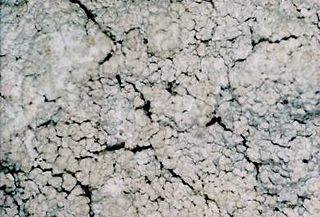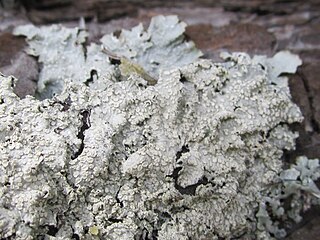
Irwin Murray Brodo is an emeritus scientist at the Canadian Museum of Nature, in Ottawa, Ontario, Canada. He is an authority on the identification and biology of lichens.

Lepraria is a genus of leprose (powdery) crustose lichens that grows on its substrate like patches of granular, caked up, mealy dust grains. Members of the genus are commonly called dust lichens. The main vegetative body (thallus) is made of patches of soredia. There are no known mechanisms for sexual reproduction, yet members of the genus continue to speciate. Some species can form marginal lobes and appear squamulose. Because of the morphological simplicity of the thallus and the absence of sexual structures, the composition of lichen products are important characters to distinguish between similar species in Lepraria.
Bacidina sorediata is a species of foliicolous (leaf-dwelling) lichen in the family Ramalinaceae. Found in the Seychelles, it was described as new to science in 2011. It is characterized by its distinct sorediate thallus and pale yellow to orange apothecia.

Punctelia caseana is a species of foliose lichen in the family Parmeliaceae. Its range covers eastern North America, extending south to central and northern Mexico, where it grows on the bark of many species of hardwood and conifer trees.
Lecanora markjohnstonii is a species of crustose lichen in the family Lecanoraceae. Found in the southern Appalachian Mountain region of the United States, it was described as a new species in 2018 by Carly Anderson Stewart, Erin Tripp, and James Lendemer. The type specimen was collected from Little River Canyon National Preserve (Alabama), where it was found growing on sandstone on a steep slope at an elevation of 1,123 m (3,684 ft). The specific epithet honors Mark Johnston, an Episcopalian priest known for his contributions to environmental education and outreach in Alabama.

Punctelia perreticulata is a widely distributed species of foliose lichen in the family Parmeliaceae. It occurs in Mediterranean Europe and Russia, North America, South America, Australia, and New Zealand, where it grows on rocks, bark, or wood. Its main distinguishing features are its thallus surface, marked with many shallow depressions, grooves, or pits, and sorediate pseudocyphellae. The lower side of the thallus is ivory to tan towards the centre and the major secondary metabolite in the medulla is lecanoric acid. A lookalike species with which it has been historically confused is Punctelia subrudecta; this lichen can be distinguished from Punctelia perreticulata by the texture of the thallus surface, or, more reliably, by the length of its conidia.
Japewiella dollypartoniana is a species of crustose lichen in the family Lecanoraceae. It is widely distributed in the Appalachian Mountains of eastern North America, and has also been reported from Ontario, Canada. The lichen grows on tree branches and sapling and shrub stems at middle to high elevations.

Lepraria harrisiana is a species of leprose lichen in the family Stereocaulaceae. It is widespread in the eastern United States where it occurs in humid habitats, such as conifer swamps and riparian forests.
Neoprotoparmelia capitata is a species of corticolous (bark-dwelling) and crustose lichen in the family Parmeliaceae. It is found in eastern North America.
Lecanora lojkahugoi is a species of saxicolous (rock-dwelling) crustose lichen in the family Lecanoraceae. It is found in the Russian Far East and in South Korea.

Lecanora louisianae is a species of corticolous (bark-dwelling), crustose lichen in the family Lecanoraceae. It was formally described as a new species in 1932 by French lichenologist Maurice Bouly de Lesdain. It is common and widespread in the Coastal Plain region of southeastern North America.
Lecanora compallens is a species of corticolous (bark-dwelling) crustose lichen in the family Lecanoraceae. Found in Asia and Europe, it was formally described as a new species in 1999 by lichenologists Kok van Herk and André Aptroot. The type specimen was collected by the first author from Drouwenerveen (Drenthe), where it was found growing on the bark of Quercus robur. The species epithet compallens is derived from the Latin com and (ex)pallens, alluding to the typical occurrence of the morphologically similar Lecanora expallens at the same location.
Lecania juniperi is a rare species of corticolous (bark-dwelling), crustose lichen in the family Ramalinaceae. Discovered on Juniperus phoenicea shrubs in the coastal region of Portugal, it was formally described as a new species in 2012. Despite its resemblance to Lecania cyrtella, L. juniperi stands out due to its warted and sorediate thallus, larger apothecia, and distinct ascospores.
Opegrapha ramisorediata is a rare species of corticolous (bark-dwelling), crustose lichen in the family Opegraphaceae. Known to occur only in northeastern Brazil, it was described as a new species in 2017. It is characterised by a thin, pale greenish-mauve thallus.
Ramboldia blochiana is a species of corticolous (bark-dwelling), crustose lichen in the family Ramboldiaceae. The species is characterized by a sorediate thallus and shares chemical and morphological characteristics with the widespread Ramboldia russula, but it also possesses distinct chemical components and a unique geographical distribution. Though it is found across tropical and subtropical regions of the New World on various substrates, its distribution might be wider than currently known due to collection biases against sterile, asexually reproducing crustose lichens.
Bacidia depriestiana is a sorediate crustose lichen that grows on the bark of Quercus alba along forested streambanks on steep slopes in the Southern Appalachian Mountains in the United States. First described in 2021, it has so far only been found in three locations, in Tennessee, North Carolina, and South Carolina.
Loekoesia is a genus of lichen-forming fungi in the family Teloschistaceae. It contains three species of saxicolous (rock-dwelling), crustose lichens. Collectively, the genus occurs in South Korea, Mauritius, and the United States. The genus is distinguished by its grey, crust-like thallus, which can be either whole or divided into patch-like segments. Loekoesia lichens have bright white, rounded soralia, which produce bluish to whitish powdery propagules (soredia) and are arranged in irregular groups on the thallus.
Rhizoplaca ouimetensis is a saxicolous (rock-dwelling), crustose lichen species in the family Lecanoraceae. Uniquely identified by its sorediate form—a feature not observed in other Rhizoplaca species—it was discovered in Ontario, Canada, specifically within the Ouimet Canyon Provincial Park.

Pseudothelomma ocellatum is a species of lignicolous (wood-dwelling), crustose lichen in the family Caliciaceae. This lichen is characterised by its grey, areolate thallus that produces abundant lichenised diaspores, such as short spherical isidia and coarse, dark brown-black soredia. It is typically sterile, meaning apothecia are absent.






